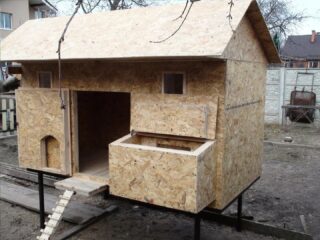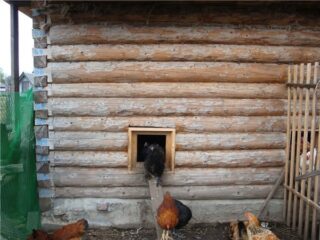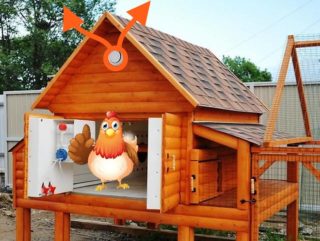A budget do-it-yourself chicken coop for home breeding of poultry can be built from a timber frame, sheathed with boards or OSB plates. You can build a reliable poultry house and block materials. When equipping a building where chickens live all year round, due attention is paid to insulation.
Choosing a place on the site

Before building a chicken coop, you need to choose the right place. They are based on the characteristics of the terrain and the characteristics of the soil. It is impossible to place a building in the lowlands, since a lot of moisture accumulates there, especially during periods of heavy rains or melting snow. This negatively affects both the health of the laying hens and the condition of the building (especially made from wood raw materials). Uplands, on the other hand, are well suited for setting up a chicken coop for broilers. You can make a building with a slope to the south side: this will ensure timely drainage of water.
For hens, it is especially important for hens to get enough sunlight into the room. This is one of the key factors in determining egg production. To achieve this, it is worth choosing a building plan when the walls, which have a large length, stretch from east to west.
Types of chicken coops
Before starting construction work, you need to prepare a project for a chicken coop, displaying the dimensions of the building, its internal layout, the location of the entrance, windows and ventilation openings, and the location of the electrical wiring. You can make a drawing yourself or use ready-made diagrams.
By design and purpose, the following types of poultry houses can be distinguished:
- Stationary premises with a foundation, erected at the site of future operation. Anyone who has experience in creating technical buildings can make a homemade chicken coop of this type. Sizes are calculated according to the number of birds. It is advisable to add some margin to the length and width (0.2-0.3 m). Feeders and drinking trays are placed inside.
- Portable chicken coops are a convenient modern option for transporting birds when moving. A mobile poultry house is an ideal choice for those who want to bring layers to the village or summer cottage from time to time. It can also be carried from place to place within the site, hidden in the house in rainy weather. The disadvantage of this option is that it is usually made for a small number of chickens. It is not possible to build a poultry house for 30 or 50 heads in this format - it is too bulky for transportation.
- A tiered chicken coop is a good option for those who need to accommodate large livestock, as well as for those waiting to replenish it. Multiple floors solve the problem of limited width.
If the number of chickens is large, you can arrange a stationary chicken coop of a large area or prefer a multi-tiered one. The latter option is good for small plots and those cases when a significant part of the area is occupied by other objects.
Requirements for the design of the chicken coop

The simplest chicken coop can be made in the form of a square or rectangular frame, sheathed with boards, OSB boards or siding. According to the norms of SNiP, adopted in 1997, the distance from the building to the fence should be at least 4 meters. The same rule applies to the distance to the border of the neighboring section. The rectangular option is convenient because it can be swept without entering the building itself (if the door is located on the long side).
When calculating the dimensions of the room, they proceed from the number of chickens. There can be 3-4 birds per 1 m² of area (if we are talking about broilers). When growing layers, the room is made more spacious, at the rate of 1 m² for every 2-3 heads. If it is decided to make a chicken coop for 10 broilers, an area of 3 m² is enough. For layers and meat and egg breeds, this value increases to 5 m². For a room for 20 birds, the area figures will be 7 and 10 m², respectively. For a similar number of geese, a more spacious room is needed.
The minimum height of a single-storey building (taking into account only the needs of birds) is 1.5 m. But since the maintenance of a chicken coop involves the presence of a person, during construction they are usually guided by the growth of the owner. The building must have a height of 0.2 m higher than this parameter.
What tools and materials will be required

You can build a chicken coop with your own hands from different types of materials at hand. Wood is widely used in various forms - it looks attractive and retains heat well. A simple and quick option to implement is a frame made of timber, sheathed with slab materials or boards.
A beautiful and warm room will turn out if you trim it with sandwich panels. Step-by-step installation instructions can be found on the product packaging. OSB boards are good because they are easy to cut and install.
Profiled sheeting and similar metal facings should not be used, despite their strength: they do not retain heat well, which will negatively affect the health of chickens in winter.
You can make a poultry house from logs, it will fit well into a rural landscape, but in practice this is rarely done, since the construction takes time to shrink. In addition, it is more difficult to build than a frame structure. The floor is best made of hardwood (for example, oak).
Building blocks (for example, foam block and aerated concrete) and bricks are suitable for a chicken coop. The latter is attractive for its good thermal insulation properties. Shell rock, which is durable and attractive in texture, is a good choice. You can also make an adobe building for birds.
When building a chicken coop, the correct organization of thermal insulation is important. Mineral wool is quite suitable for frame buildings. It protects birds from predators (they cannot gnaw through a layer of cotton wool), and also has sufficient vapor permeability.
Sometimes, to save money, polystyrene is used as a heater, but it does not allow moisture to pass through.
A common drawback of these materials is that they often get mice. To prevent this, a fine-mesh metal mesh can be placed on the walls on both sides. Plastering the surface using a mesh is sometimes practiced.
Extruded polystyrene foam has the best performance characteristics. It is more expensive, but it does not get mice, fungi and mold. To insulate frame walls, a layer of small thickness is enough (2-3 cm - while foam is needed 2 times more), so the resulting costs are not too high.
For block buildings, expanded clay is often used.
How to make a chicken coop with your own hands

For a building erected using frame technology, a foundation of pillars would be the optimal solution. To build from blocks, a slab base is required. Columnar legs are placed at the four corners and around the perimeter of the building. The distance between them is 1 m. A layer of sand is poured into the prepared pits and concrete is poured. He is allowed to harden for 3 days, and then blocks or bricks are mounted on the supports.
Logs are mounted on a waterproofed foundation, and rough boards are mounted on them. They are covered with a layer of roofing material and bars are stuffed at a distance of 70-80 cm from each other. Insulation is placed in the intervals (for example, expanded clay). Then finishing flooring is done.All wooden elements are treated with antiseptic and flame retardant compounds.
They proceed to the formation of the frame of the building, installation and insulation of the walls. The preferred form of the roof of the chicken coop is gable: moisture comes off it faster. Water retention can contribute to indoor climate degradation. A crate is installed on the rafters, and a roof covering is mounted on top. The ceiling should be insulated with the same material as the walls.
To avoid drafts, do not install windows on the side of the room opposite the door.
Ventilation can be forced or natural.
Next to the building, you can organize a yard for summer walking with dimensions of 2x2 m. A canopy is installed above it. The chicken coop should have a special door leading to the courtyard. Its territory is fenced off with a net. It should be dug in at least on the bayonet of a shovel in order to adequately protect birds from predatory animals. Bricks are laid close to it around the perimeter. Several perches are placed inside.
In winter, strict adherence to the lighting regime is required in the chicken coop. This is especially important when keeping layers, as it directly affects egg production. Fluorescent and LED products are best suited. They are more efficient and last longer than simple incandescent bulbs. The latter can be used for a small chicken coop for several heads. They have a short lifespan and will have to be replaced regularly.









digging in foundation pillars every meter is too much